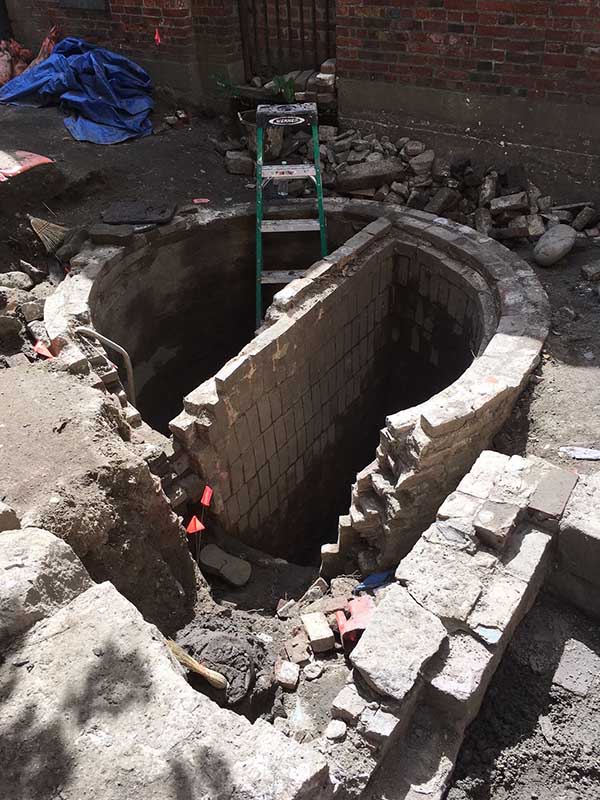#Dignorth – the Bifurcated Cistern in Washington Garden

For the second summer in a row, archaeologists armed with trowels and screens have descended upon the Washington Garden in search of clues of what life was like for the inhabitants of 2 and 3 Unity Court, tenement buildings that were only one of many that made up the North End in the nineteenth century. Last summer, city archaeologist Joe Bagley and his crew uncovered the privy system used by the inhabitants of those tenement buildings, while this summer they have turned their attention to the cistern in the backyard.
By Chloe Lin, Old North Foundation Educator
For the second summer in a row, archaeologists armed with trowels and screens have descended upon the Washington Garden in search of clues of what life was like for the inhabitants of 2 and 3 Unity Court, tenement buildings that were only one of many that made up the North End in the nineteenth century. Last summer, city archaeologist Joe Bagley and his crew uncovered the privy system used by the inhabitants of those tenement buildings, while this summer they have turned their attention to the cistern in the backyard.
One of the surprises encountered by the archaeologists this summer is the cistern itself, a rainwater storage tank. The cistern was actually built to accommodate both households – instead of building two separate cisterns, they built just one and put a wall down the center to divide it! The cistern was built in 1830, along with the tenement buildings, by a man named Timothy Carter, who founded the Old Corner Bookstore. Carter was a land speculator who built the properties at Unity Court all at once, conceiving of these individual tenement units as one group. Thus, one cistern was built for each side, something that Bagley had yet to encounter or even hear of before while working as the city archaeologist.
Aside from the unique bifurcated cistern, the archaeological site is special in other ways. The Unity Court buildings were not particularly unique when they were built, they were just another set of tenement buildings like the others that made up the North End. However, the site where they were has been undisturbed for decades, unlike the rest of the North End, which has been heavily redeveloped and built over. This means it’s a perfect chance for Bagley and his crew to uncover artifacts that have been untouched since they were first discarded. The artifacts in the eight-foot deep cistern span the time period between 1830 and 1870, and some particular favorites of the crew have been pipes decorated with clover and an eagle. They have also discovered, strangely enough, intact forks at the bottom of both cisterns – Bagley speculates that this might be an unlikely coincidence or evidence of a cistern-opening ritual! The objects discovered so far seem to correspond with Irish families who may have been wealthier than average in the North End. Although the area had become a tenement slum and was all but abandoned by city officials in the nineteenth century, Unity Court was located in a quiet off-road, which may mean that wealthier inhabitants there were slower to leave the area than their neighbors on busier streets.
Excavating the cistern has been slow going – partially because the cistern is still functioning nearly two hundred years after it was built! A rainy spring has meant that the archaeologists can’t sift through dirt using their screens, but instead are going over piles of mud by hand to uncover artifacts. This phase of the dig is nearly over, however, and the crew will all get a few week’s breaks before returning to the site in June for the next portion of their dig!
